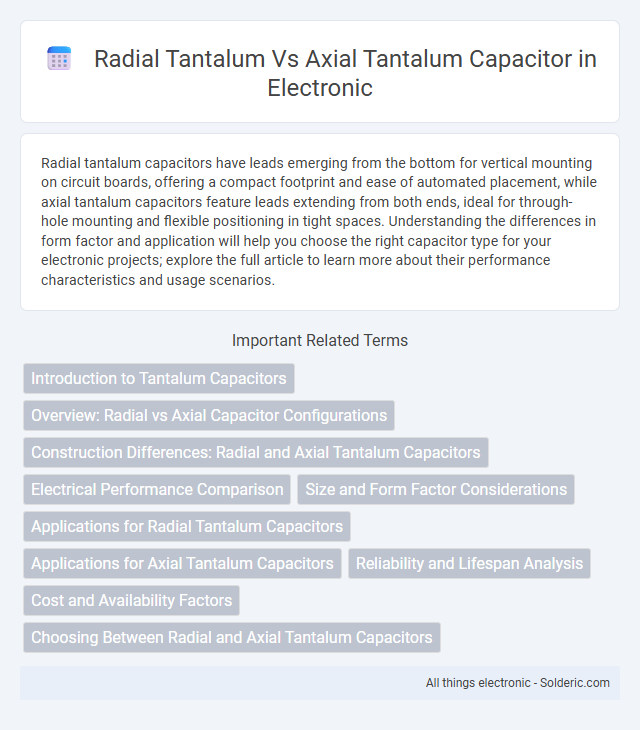Radial tantalum capacitors have leads emerging from the bottom for vertical mounting on circuit boards, offering a compact footprint and ease of automated placement, while axial tantalum capacitors feature leads extending from both ends, ideal for through-hole mounting and flexible positioning in tight spaces. Understanding the differences in form factor and application will help you choose the right capacitor type for your electronic projects; explore the full article to learn more about their performance characteristics and usage scenarios.
Comparison Table
| Feature | Radial Tantalum Capacitor | Axial Tantalum Capacitor |
|---|---|---|
| Lead Orientation | Leads emerge from the same side (bottom) | Leads extend from both ends (axial) |
| Mounting Style | Vertical (radial) mounting | Horizontal (axial) mounting |
| Space Efficiency | More compact footprint on PCB | Longer profile, requires more PCB length |
| Application | High-density circuit boards, space-constrained designs | Through-hole mounting, mechanical stress resistance |
| Mechanical Stability | Moderate; less resistant to mechanical stress | Higher resistance to vibrations and mechanical stress |
| Capacitance Range | Typically 0.1uF to 1000uF | Typically 1uF to 560uF |
| Voltage Ratings | Up to 50V or higher | Up to 35V or higher |
| Cost | Generally lower cost | Generally higher cost due to construction |
Introduction to Tantalum Capacitors
Tantalum capacitors are distinguished by their construction styles, with radial and axial types serving different design needs in electronic circuits. Radial tantalum capacitors feature leads emerging from the bottom, enabling compact PCB layouts and enhanced automated assembly, while axial capacitors have leads on opposite ends, allowing easier mounting in through-hole designs with space constraints along the board's surface. Both types offer high capacitance per volume, stable capacitance over temperature, and excellent frequency performance, making them ideal for critical power supply filtering, timing, and decoupling applications in advanced electronics.
Overview: Radial vs Axial Capacitor Configurations
Radial tantalum capacitors have leads extending from one end, making them ideal for compact circuit board layouts and automated assembly processes. Axial tantalum capacitors feature leads on opposite ends, offering stability in applications requiring robust mechanical support and easy insertion into through-hole boards. Your choice between radial and axial configurations depends on space constraints and mounting requirements in your electronic design.
Construction Differences: Radial and Axial Tantalum Capacitors
Radial tantalum capacitors feature leads extending from the same side of the capacitor body, allowing for more compact PCB layouts and ease of automated assembly. Axial tantalum capacitors have leads protruding from opposite ends of the cylindrical body, providing better mechanical stability and reduced stress in specific applications. Understanding these construction differences helps optimize your circuit design for size constraints and durability requirements.
Electrical Performance Comparison
Radial tantalum capacitors typically offer lower equivalent series resistance (ESR) and improved ripple current handling compared to axial tantalum capacitors, enhancing electrical efficiency in high-frequency applications. Axial tantalum capacitors provide stable capacitance with better mechanical flexibility, which can be advantageous in circuits requiring vibration resistance. The choice between radial and axial configurations depends on balancing ESR values, capacitance stability, and installation space constraints in the electrical design.
Size and Form Factor Considerations
Radial tantalum capacitors typically feature a compact and cylindrical shape with leads extending from one end, making them ideal for automated PCB assembly and tight spaces. Axial tantalum capacitors have leads on both ends and a longer, more linear form factor, which suits designs requiring low profile but extended length components. Your choice between radial and axial tantalum capacitors depends on space constraints and layout preferences within your electronic device.
Applications for Radial Tantalum Capacitors
Radial tantalum capacitors are commonly used in compact electronic devices requiring high capacitance in limited board space, such as smartphones, laptops, and portable medical instruments. Their design facilitates automated assembly and stable performance in power supply filtering, decoupling, and energy storage in consumer electronics and automotive applications. These capacitors excel in environments where reliability and long life are critical, including aerospace and military systems.
Applications for Axial Tantalum Capacitors
Axial tantalum capacitors are widely used in applications requiring stable capacitance and reliability in confined spaces, such as in aerospace, military devices, and medical equipment. Their axial leads enable easier insertion into narrow circuit boards and enhanced mechanical stability in high-vibration environments. These capacitors are ideal for power supply filtering, signal coupling, and timing circuits where long-term durability and compact design are critical.
Reliability and Lifespan Analysis
Radial tantalum capacitors generally provide enhanced mechanical stability due to their lead configuration, resulting in improved reliability under vibration and shock conditions compared to axial tantalum capacitors. The sealed construction and shorter lead length in radial types reduce the risk of internal damage and electrolyte drying, thereby extending their operational lifespan. Axial tantalum capacitors may experience higher failure rates in dynamic environments, limiting their long-term durability relative to radial counterparts.
Cost and Availability Factors
Radial tantalum capacitors generally offer lower cost and higher availability due to simpler packaging and widespread use in consumer electronics. Axial tantalum capacitors, while often more expensive, are preferred for specialized applications requiring robust mechanical stability and higher reliability. Supply chain constraints and raw material scarcity can impact both types, but axial versions typically face greater price volatility.
Choosing Between Radial and Axial Tantalum Capacitors
Choosing between radial and axial tantalum capacitors depends on your circuit layout and space constraints. Radial tantalum capacitors feature leads on one side, making them ideal for compact, vertical mounting on PCBs, optimizing board space. Axial tantalum capacitors have leads on both ends, suited for through-hole applications that require component alignment parallel to the PCB, providing mechanical stability in linear layouts.
radial tantalum vs axial tantalum capacitor Infographic

 solderic.com
solderic.com